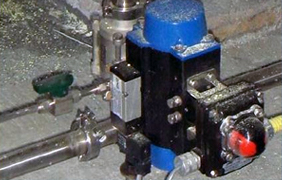Major Components: Power Supplies & Controls
The power supply system is designed to provide voltage to the electrical field (or bus section) at the highest possible level. The voltage must be controlled to avoid causing sustained arcing or sparking between the electrodes and the collecting plates.
Electrically, a precipitator is divided into a grid, with electrical fields in series (in the direction of the gas flow) and one or more bus sections in parallel (cross-wise to the gas flow). When electrical fields are in series, the power supply for each field can be adjusted to optimize operation of that field. Likewise, having more than one electrical bus section in parallel allows adjustments to compensate for their differences, so that power input can be optimized. The power supply system has four basic components:
- Automatic voltage control
- Step-up transformer
- High-voltage rectifier
- Sensing device
Voltage Control
Automatic voltage control varies the power to the transformer-rectifier in response to signals received from sensors in the precipitator and the transformer-rectifier itself. It monitors the electrical conditions inside the precipitator, protects the internal components from arc-over damages, and protects the transformer-rectifier and other components in the primary circuit.
The ideal automatic voltage control would produce the maximum collecting efficiency by holding the operating voltage of the precipitator at a level just below the spark-over voltage. However, this level cannot be achieved given that conditions change from moment to moment. Instead, the automatic voltage control increases output from the transformer-rectifier until a spark occurs. Then the control resets to a lower power level, and the power increases again until the next spark occurs.
Theory
- Optimize Power Application
The primary purpose of a voltage controller is to deliver as much useful electrical power to the corresponding electrostatic precipitator field(s) as possible. This is not an easy job; electrical characteristics in the field(s) are constantly changing, which is why a voltage controller is required. - Spark Reaction
When the voltage applied to the electrostatic precipitator field is too high for the conditions at the time, a spark over will occur. Detrimentally high amounts of current can occur during a spark over if not properly controlled, which could damage the fields. A voltage controller will monitor the primary and secondary voltage and current of the circuit, and detect a spark over condition. Once detected, the power applied to the field will be immediately cut off or reduced, which will stop the spark. After a short amount of time the power will be ramped back up, and the process will start over. - Protect System Components by Adhering to Component Limitations
The Transformer Rectifier set (TR set) can be damaged by excessive amounts of current or voltage flowing through it. Each TR set has voltage and current limits established by the manufacturer, which are labeled on an attached nameplate. These nameplate limit values (typically primary and secondary current, and voltage) are programmed into the voltage controller. Through metering circuits, the voltage controller will monitor these values, and ensure these limits are not exceeded. - Tripping
When a condition occurs that the voltage controller cannot control, often times the voltage controller will trip. A trip means the voltage controller (by way of the contactor) will shut off the individual precipitator power circuit. A short inside the electrostatic precipitator field caused by a fallen discharge electrode (wire), or a shorted out Silicone Controlled Rectifier are examples of conditions that a voltage controller cannot control.
Operation
To maximize electrostatic precipitator efficiency, a voltage controller usually attempts to increase the electrical power delivered to the field. However in some conditions a voltage controller must just maintain power at a constant level. Increased electrical power into the electrostatic precipitator directly correlates with better precipitator performance, but there is a limit. If too much voltage is applied for a given condition (as mentioned in the spark reaction section), a spark over will occur. During a spark over precipitator performance in that field will drop to zero, rendering that field temporarily ineffective.
To overcome the crippling effect that spark over has to increasing the electrical power in the precipitator field, spark response algorithms have been developed that will interrupt power upon detection of a spark, then ramp power back up to a high level. These response algorithms can greatly influence overall precipitator performance.
- Transformer/Rectifiers – The T/R set rating should be matched to the load imposed by the electrical field or bus section. The power supply will perform best when the T/R set operates at 70 – 90% of the rated capacity, without excessive sparking. This reduces the maximum continuous-load voltage and corona power inputs. Practical operating voltages for T/R sets depend on:
- Collecting plate spacing
- Gas and dust conditions
- Collecting plate and discharge electrode geometry
- At secondary current levels over 1500 mA, internal impedance of a T/R set is low, which makes stable automatic voltage control more difficult to achieve. The design of the T/R set should call for the highest possible impedance that is commensurate with the application and performance requirements. Often, this limits the size of the electrical field or bus section. ¨It is general practice to add additional impedance in the form of a current-limiting reactor in the primary circuit. This reactor will limit the primary current during arcing and also improve the wave shape of the voltage/current fed into the T/R set.
- Corona current density should be in the range of 10 – 100 mA/1000 ft2 of plate area. (Calculate this using secondary current divided by collecting area of the electrical field or bus section.) The actual level depends upon:
- Location of electrical field or bus section to be energized
- Collecting plate area
- Gas and dust conditions
- Collecting electrode and discharge wire geometry
Helpful Resources
KnowledgeBase: Theory of Operations: Charging
KnowledgeBase: Optimize Corona Power
KnowledgeBase: Troubleshooting
KnowledgeBase: Optimizing Precipitator Power Circuits
KnowledgeBase: Understanding CLRs
Our Capabilities: Control Systems
Our Capabilities: Precipitator Power Components


